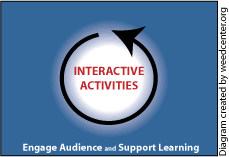The Players—Presenter And Audience
THE PRESENTER HAS A MISSION

Making a presentation to the public, whether to a garden club, scout group or refuge visitors, can be a little intimidating. But preparation and enthusiasm can go a long way toward calming nerves and instilling confidence.
It’s easy to think of a presentation as being about the presenter, but if you think of a talk as being about conveying information about an important topic, in this case "weed awareness," it may be easier to present. Having a worthwhile mission can make talking in front of a group more comfortable.
THE AUDIENCE AS LEARNERS
Active Learning

There are as many styles of presentations as there are presenters. Creating an active rather than passive presentation not only keeps participants interested but helps them retain new information. Learners only retain about 5% of information presented in a lecture-only format.
Any amount of participant interaction will go a long way toward engaging an audience and helping them learn about invasive plants. By crafting a presentation that incorporates interactive activities, the audience will remember more than if they were just listening. Plus, it is more likely that an interactive presentation will tap into different learning styles and reach more of the audience.
Learning Styles
Learning styles are simply different ways in which people learn. By understanding these styles, presentations can be developed to reach all types of learners in an audience more effectively. People may have more than one learning style but generally learn most effectively through one.

Visual Learners – learn by seeing
- prefer visual aids such as charts, graphs, pictures, and hand-outs
- like to take notes

Auditory Learners – learn by listening
- do well listening to lectures, talking, and listening to others
- written text may not have much meaning until it is heard aloud

Tactile/Kinesthetic Learners – learn by moving and doing
- like to participate in hands-on activities
- may get distracted and lose interest if asked to sit still too long



